If Time Stopped Moving How Would You Make It Move Again
Yous can apply motion path animation effects to move slide objects in a sequence that tells an constructive story.
For instance, the plane on the right (below) shows the starting bespeak of the plane, and the dotted line between the two planes shows the path it will take when the blitheness plays. The transparent image on the left is where the aeroplane volition end up when the motion path animation is done.

1:14
Microsoft 365 subscribers have an easier option for motion-based animation: Morph
Add together a motion path to an object
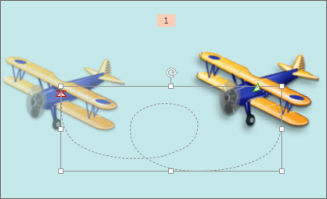
-
Click the object you desire to animate.
-
On the Animations tab, click Add together Blitheness.

-
Curl downwardly to Motion Paths, and pick i.

Tip: If you lot cull the Custom path option, you will draw the path that you desire the object to take.

To terminate cartoon a custom path, press Esc.
Avant-garde motility path options
-
If you don't run into a motion path that you desire, at the lesser of the gallery, click More than Movement Paths.
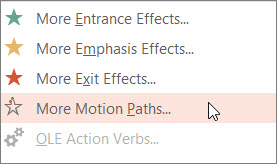
Click an blitheness to see a preview of how the object will move on your slide.
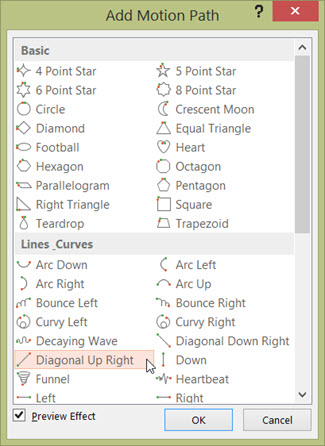
-
In one case you pick the motion path you want, click OK.
To remove and animation, on the slide, click the motion path (dotted line with arrow), and then press Delete.
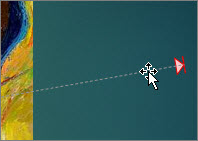
Editing motion paths
-
To do things like change the direction of the move path, edit the individual points of the motion path, or to lock (make information technology so others can't modify the animation) or unlock the animation, click Effect Options.
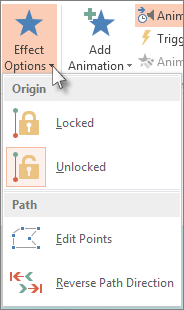
-
To preview the motion path, click the object on the slide, and and so click Animations > Preview.
Tip: Preview is located on the Animations tab, just below the File tab on the far left.
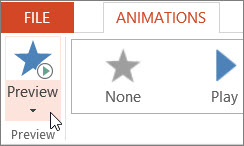
Using predefined paths
In near cases, using one of the bones path animations is a perfect choice for adding interest to your slide. In the following instance, we'll apply a Turn path animation to a graphic, use Effect Options to change the direction of the path, and then we'll use Reverse Path Direction to get the terminal expect nosotros want.
Case: applying a predefined path animation to a graphic
-
On a blank slide, click Insert > Shapes > Rectangle (or another shape if you prefer), and then click in the upper-left corner of the slide to insert it.
-
With the rectangle yet selected, click Animations > Path Animation, and then under Basic, click Plow.
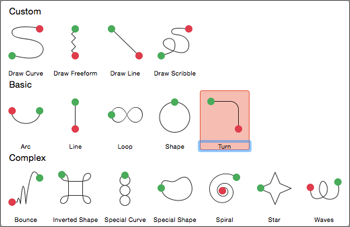
-
Subsequently the animation preview is finished and click Upshot Options on the Animations tab, so click Downward Right.
-
Move your cursor over the animation finish-point until it changes to a double pointer with a line through it, and then click and elevate to the lower-right corner of the slide.
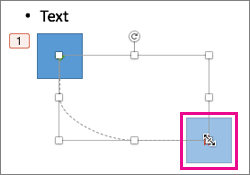
-
Finally, click Effect Options > Reverse Path Management.
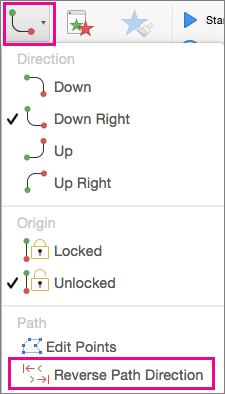
The blitheness at present moves the graphic from the least visible place on the slide (lower correct) to the near visible (upper left).
Using custom paths
To depict a custom path animation, select the object you want to animate and click Animations > Path Animations, and then select an selection nether Custom. The drawing method is different depending on the type of path you choose.
If you selected a Curve or Freeform path: 
-
Click the offset signal, and then click each time you desire to begin a change of management.
-
Double-click to cease.
If you selected a Line or Scribble path: 
-
Click and agree the mouse button to trace the shape y'all desire, and then release the button when you're done.
To change a custom path once you've drawn it:
-
Control+click or right-click the custom path and click Edit Points.
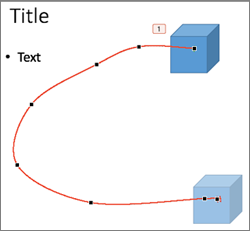
Tip:If you've never worked with editing paths in a graphics plan before, you may find it easier to delete the effect and describe it once more.
Utilise a motion path to an object or text
-
Select the text or object that you want to apply an animation event to.
-
On the Animations tab, under Movement, click Paths, then under Basic or Complex, click the blazon of motion path that you desire.

Tips:
-
The arrows that show the motion path when y'all are editing the animation are non visible to your audition during the slide show.
-
To preview all animation effects on the slide, on the Animations tab, under Preview, click Play.
-
Draw a custom motion path
-
Select the text or object that you want to apply an animation effect to.
-
On the Animations tab, nether Move, click Paths, and and then click Draw Curve, Draw Freeform, Describe Line, or Draw Scribble.

-
To draw the move path that you selected, do one the post-obit:
| To | Exercise this |
|---|---|
| Draw a curve | Click the position on the slide where you want to beginning the path, and then move the pointer along a line. Click wherever you want a curve noon in the path. Double-click at whatever betoken to finish cartoon the path. |
| Depict a freeform path that includes directly lines | Click the position on the slide where yous want to start the path, motility the pointer in a direction to draw a straight line, and then click at whatever point that you want to create a corner. Or, click and so hold down the mouse as your move the mouse in any management to depict a path that appears hand-drawn. Click wherever you want to change between these drawing methods. Double-click at any point to finish cartoon the path. |
| Depict a line | Click the position on the slide where you want to get-go the path, concord down the mouse push, and then drag the pointer in a direction to draw a straight line. Release the mouse button to stop drawing the path. |
| Describe a path that appears hand-drawn, or scribbled | Click the position on the slide where y'all desire to start the path, hold down the mouse push button, and so drag the pointer in any direction. Release the mouse push button to stop cartoon the path. |
Tips:
-
If y'all desire the curve or freeform path to finish where it started (referred to as "closing" the path), click the starting signal of the path to cease drawing the path, instead of double-clicking or releasing the mouse push.
-
To preview all blitheness furnishings on the slide, on the Animations tab, under Preview, click Play.
Arrange the path of the animation
-
In the navigation pane, select the slide that contains the animation outcome that you lot desire to change, and and so click the Blitheness tab.
How to select slides in the navigation pane
-
On the View menu, click Normal.
-
In the top of the navigation pane, click the Slides
 tab, and then click a slide. Depending on the width of the navigation pane, you will either meet the
tab, and then click a slide. Depending on the width of the navigation pane, you will either meet the  and
and  named tabs or the Slides
named tabs or the Slides  and Outline
and Outline  icon tabs.
icon tabs.
-
-
On the slide, select the animation effect that you desire to change.
Tips:
-
Each blitheness effect is represented on the slide past a number
 next to the object, which indicates the social club that information technology volition play in. If two animation effects are set to play at the aforementioned fourth dimension, they are represented past a numbered stack
next to the object, which indicates the social club that information technology volition play in. If two animation effects are set to play at the aforementioned fourth dimension, they are represented past a numbered stack  .
. -
To select an blitheness effect that is in a numbered stack
 , you must view the total list of animation effects on the slide. On the Animations tab, under Animation Options, click Reorder, and then click the animation that you desire.
, you must view the total list of animation effects on the slide. On the Animations tab, under Animation Options, click Reorder, and then click the animation that you desire.
-
-
On the Animations tab, nether Animation Options, click Result Options, and then click Edit Points.

-
Drag an edit bespeak on the path blitheness to arrange the shape.
Tip:To preview all animation effects on the slide, on the Animations tab, under Preview, click Play.
Reverse the direction of the motion path
-
In the navigation pane, select the slide that contains the animation effect that you desire to modify, so click the Animation tab.
How to select slides in the navigation pane
-
On the View menu, click Normal.
-
In the pinnacle of the navigation pane, click the Slides
 tab, and so click a slide. Depending on the width of the navigation pane, yous will either see the
tab, and so click a slide. Depending on the width of the navigation pane, yous will either see the  and
and  named tabs or the Slides
named tabs or the Slides  and Outline
and Outline  icon tabs.
icon tabs.
-
-
On the slide, select the blitheness effect that you desire to change.
Tips:
-
Each blitheness consequence is represented on the slide past a number
 next to the object, which indicates the order that information technology will play in. If two animation effects are gear up to play at the same time, they are represented by a numbered stack
next to the object, which indicates the order that information technology will play in. If two animation effects are gear up to play at the same time, they are represented by a numbered stack  .
. -
To select an animation effect that is in a numbered stack
 , you must view the full list of animation effects on the slide. On the Animations tab, nether Blitheness Options, click Reorder, and and then click the animation that y'all want.
, you must view the full list of animation effects on the slide. On the Animations tab, nether Blitheness Options, click Reorder, and and then click the animation that y'all want.
-
-
On the Animations tab, under Animation Options, click Effect Options, so click Opposite Path Direction.

Tip:To preview all animation effects on the slide, on the Animations tab, under Preview, click Play.
Close or open the path
A motion path is "closed" if the path ends where it started. A motion path is "open up" if it ends in a different location than where it started.
-
In the navigation pane, select the slide that contains the animation effect that you want to change, and and so click the Animation tab.
How to select slides in the navigation pane
-
On the View menu, click Normal.
-
In the height of the navigation pane, click the Slides
 tab, and then click a slide. Depending on the width of the navigation pane, you will either see the
tab, and then click a slide. Depending on the width of the navigation pane, you will either see the  and
and  named tabs or the Slides
named tabs or the Slides  and Outline
and Outline  icon tabs.
icon tabs.
-
-
On the slide, select the animation effect that you want to change.
Tips:
-
Each animation effect is represented on the slide by a number
 next to the object, which indicates the order that it will play in. If ii animation effects are set to play at the aforementioned time, they are represented by a numbered stack
next to the object, which indicates the order that it will play in. If ii animation effects are set to play at the aforementioned time, they are represented by a numbered stack  .
. -
To select an animation effect that is in a numbered stack
 , you must view the full list of blitheness effects on the slide. On the Animations tab, under Animation Options, click Reorder, so click the animation that yous want.
, you must view the full list of blitheness effects on the slide. On the Animations tab, under Animation Options, click Reorder, so click the animation that yous want.
-
-
Do whatever of the following:
| To | Do this |
|---|---|
| Open a closed path | Hold down Command , click the motion path on the slide, and then on the shortcut menu, click Open Curve. |
| Close an open up path | Hold down CONTROL , click the motion path on the slide, then on the shortcut menu, click Close Curve. |
To preview all animation effects on the slide, on the Animations tab, under Preview, click Play.
Movement the motion path on the slide
-
In the navigation pane, select the slide that contains the blitheness effect that you desire to modify, and then click the Animation tab.
How to select slides in the navigation pane
-
On the View menu, click Normal.
-
In the top of the navigation pane, click the Slides
 tab, and and then click a slide. Depending on the width of the navigation pane, yous will either come across the
tab, and and then click a slide. Depending on the width of the navigation pane, yous will either come across the  and
and  named tabs or the Slides
named tabs or the Slides  and Outline
and Outline  icon tabs.
icon tabs.
-
-
On the slide, select the animation effect that you want to change.
Tips:
-
Each animation effect is represented on the slide by a number
 adjacent to the object, which indicates the order that it will play in. If two animation effects are set up to play at the same time, they are represented by a numbered stack
adjacent to the object, which indicates the order that it will play in. If two animation effects are set up to play at the same time, they are represented by a numbered stack  .
. -
To select an animation effect that is in a numbered stack
 , yous must view the total list of animation effects on the slide. On the Animations tab, under Animation Options, click Reorder, and so click the animation that you want.
, yous must view the total list of animation effects on the slide. On the Animations tab, under Animation Options, click Reorder, and so click the animation that you want.
-
-
Residual the pointer over the motion path until it becomes a
 , then drag the move path to the new location.
, then drag the move path to the new location.To preview all animation effects on the slide, on the Animations tab, under Preview, click Play.
Source: https://support.microsoft.com/en-us/office/add-a-motion-path-animation-effect-f3174300-0d24-4671-a1c2-e286b41efba6
0 Response to "If Time Stopped Moving How Would You Make It Move Again"
Post a Comment